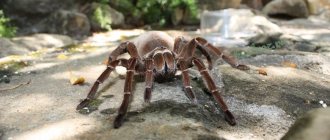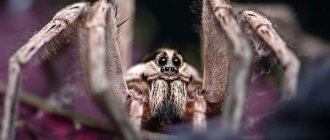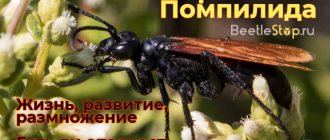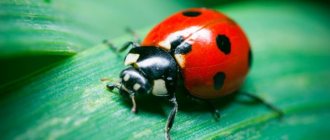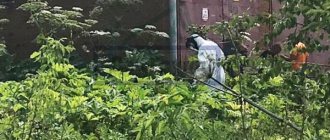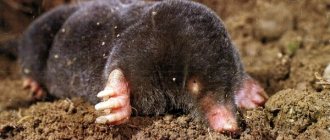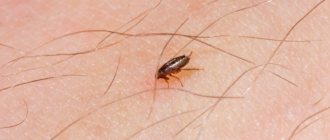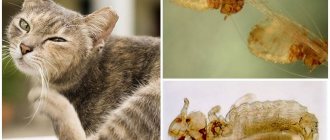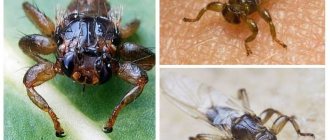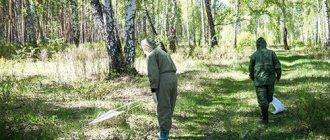How to Identify a Crab Spider
Sidewalk spiders or crab spiders (Thomisidae) are so named because of their resemblance to crabs.
Their first two pairs of legs grow from the sides and are longer than the back two pairs. Crab spiders are almost always found outdoors. They do not spin webs; instead, they catch prey with their front legs. The crab spider can remain in one place (for example, on a flower petal) for several days or even weeks, waiting for its prey. In appearance and movement, crab spiders resemble water crabs. They can walk forward, sideways and even backwards.
Crab spiders do not spin webs to catch their prey. These are hunting spiders that camouflage themselves and wait patiently for their prey to approach them.
Orb-weaving spiders
These spiders, on the contrary, have very small eyes, since orb weavers are excellent at using other senses. Orb-weaving spiders are skilled web builders. The web consists of triangles connected to each other and converging at one of the corners into a common center, forming a circle. Inside each triangle there is a web woven, spreading from the center to the edges. Moreover, the web has a very neat appearance, the cells of one row do not differ from each other in size and increase in proportion to the web. Interestingly, the size of the cells varies by the builder depending on what kind of production he is counting on: small or large.
Description of appearance
There are 170 genera and more than 2,000 species of sidewalkers around the world. They differ from other types of spiders in their forelimbs. Two pairs of front legs are much longer than the others, turned upside down. Reminds me of crab claws. Thanks to this feature, the spider can walk sideways in different directions.
Females reach a size of 1.2 cm, males are half that size. The color is very different - green, pink, yellow, white, red, brown. Most colorful species live in flower buds, blending in to match the petals. The crab is brown and dark in color and lives in the bark of trees and forest floors. A photo of the sidewalk spider is located below.
Classification
There are 175 genera with 2103 species in the sidewalk spider family.
- Acentroscelus
- Acrotmarus
- Alcimochthes
- Amyciaea
- Angaeus
- Ansea
- Aphantochilus
- Apyretina
- Ascurisoma
- Australomisidia
- Avelis
- Bassaniana
- Bassaniodes
- Boliscodes
- Boliscus
- Bomis
- Bonapruncinia
- Boomerangia
- Borboropactus
- Bucranium
- Camaricus
- Carcinarachne
- Cebrenninus
- Ceraarachne
- Cetratus
- Coenypha
- Coriarachne
- Corynethrix
- Cozyptila
- Cymbacha
- Cymbachina
- Cynathea
- Cyriogonus
- Deltoclita
- Demogenes
- Diaea
- Dietopsa
- Dimizonops
- Diplotychus
- Domatha
- Ebelingia
- Ebrechtella
- Emplesiogonus
- Epicadinus
- Epicadus
- Epidius
- Erissoides
- Erissus
- Felsina
- Firmicus
- Geraesta
- Gnoerichia
- Haedanula
- Haplotmarus
- Hedana
- Henriksenia
- Herbessus
- Heriaesynaema
- Heriaeus
- Heterogriffus
- Hewittia
- Hexommulocymus
- Holopelus
- Ibana
- Indosmodicinus
- Indoxysticus
- Iphoctesis
- Isala
- Isaloides
- Lampertia
- Latifrons
- Ledouxia
- Lehtinelagia
- Leroya
- Loxobates
- Loxoporetes
- Lycopus
- Lysiteles
- Massuria
- Mastira
- Mecaphesa
- Megapyge
- Metadiaea
- Micromisumenops
- Misumena
- Misumenoides
- Misumenops
- Misusesus
- modysticus
- Monaeses
- Musaeus
- Mystaria
- Narcaeus
- Nyctimus
- Ocyllus
- Onocolus
- Ostanes
- Oxytate
- Ozyptila
- Pactactes
- Pagida
- Parabomis
- Parasmodix
- Parastrophius
- Parasynema
- Pasias
- Pasiasula
- Peritraeus
- Phaenopoma
- Pharta
- Pherecydes
- Philodamia
- Philogaeus
- Phireza
- Phrynarachne
- Physoplatys
- Pistius
- Plancinus
- Plastonomus
- Platyarachne
- Platythomisus
- Poecilothomisus
- Porropis
- Pothaeus
- Prepotelus
- Pseudamyciaea
- Pseudoporrhopis
- Pycnaxis
- Pyresthesis
- Reinickella
- Rejanellus
- Rhaeobates
- Runcinia
- Runcinioides
- Saccodomus
- Scopticus
- Sidymella
- Simorcus
- Sinothomisus
- Smodicinodes
- Smodicinus
- Soelteria
- Spilosynema
- Stephanopis
- Stephanopoides
- Stiphropella
- Stiphropus
- Strigoplus
- Strophius
- Sylligma
- Synaemops
- Synalus
- Synema
- Tagulinus
- Tagulis
- Takachihoa
- Talaus
- Tarrocanus
- Taypaliito
- Tharpyna
- Tharrhalea
- Thomisops
- Thomisus
- Titidiops
- Titidius
- Tmarus
- Tobias
- Trichopagis
- Ulocymus
- Uraarachne
- Wechselia
- Xysticus
- Zametopias
- Zametopina
- Zygometi
Body structure and coloring
Females are twice the size of males and can reach a length of 1-1.2 cm. Modified forelimbs allow spiders to move quickly and instantly pull food into their “embraces.” The color of these amazing creatures comes in almost all shades - white, pink, lemon, brown, green, red. The brightest representatives of this species live inside flower buds. Darker ones, with spots and patterns, live on the bark of trees and the ground. The white sidewalk spider is able to merge with the petals, as it has not only a milky body, but also eyes of the same shade.
Body structure
Body structure features are easier to analyze in the flowery yellow sidewalk spider (Misumena vatia). The name of the subspecies is explained by its habitat. Misumena most often lives on mushrooms and yellow flowers. These plants act as excellent camouflage from predators.
The body of a predator can be roughly divided into two parts connected by a small tube. The back row of eyes is wider than the front row. The hind eyes are widely spaced. The jaw is vertical, the segments are flattened and closely approximated.
The claws of the chelicerae are small but thick. Large venom glands occupy most of the cephalothorax and end behind the brain. Spider warts are found on the lower surface of the abdomen.
The male's body is usually covered with silky erect hairs. The knees are long, but thinner than the hips. The tibiae are almost cylindrical. The front pairs of legs are equipped with two rows of large ventral spines and smaller spines on the edges of the limbs.
Most of the representatives have a smooth body. Individuals are called “crabs” due to their characteristic limbs, which help them move not only forward, but backward and sideways.
The body is distinguished by the following features characteristic only of this species:
- the head and chest parts are located separately from each other.
- Two pairs of limbs are attached to the head. They have claws with poisonous glands.
- The tentacles are formed from six segments.
- On the frontal part there are 2 main eyes and 6 additional ones.
- The ability to move sideways is determined by the front pairs of limbs turned upward.
- All organs are located inside the oval-shaped abdomen, under which the genital opening is located.
- The front legs are 4-5 times longer than the rest.
- The body is very small in size, not exceeding 1 cm in females, 0.5 cm in males.
- It can change its color like a chameleon.
The structural features of the body help it deftly and imperceptibly make its way sideways between leaves and flowers, penetrate into a crevice in a tree, or run across to another surface.
Peculiarities
Sidewalk spiders do not spin webs to catch flying insects. Female spiders make sacs from this sticky substance into which they lay their eggs. They also use webs to descend from taller plants to lower ones. But the most amazing thing is that with the onset of autumn they use it as a means of transport. Having ridden the bags, they are able to go on a long journey with the first gust of wind. In warm and dry weather, they cover a distance of several kilometers. Sometimes you can see a whole family of spiders on one web. To stop at a place they like, they simply shoot a web onto the nearest tree or plant.
Hunter Tactics
Despite their size, spiders are not afraid to attack larger insects. Like real hunters, they can sit in ambush for a long time, waiting for prey with open paws. As soon as a butterfly or wasp lands on a flower, they instantly grab them and bite them in vulnerable places. Having injected the poison, the flower spider begins to eat. However, if a hunter has not eaten for a long time, then his behavior changes radically. He runs restlessly through the leaves, looking for prey and moving his paws in anticipation of lunch. At the sight of an approaching insect, the spider freezes with its legs wide open. From the outside it seems that he opened friendly arms. Thanks to their coloring, they manage to remain unnoticed, and the tactic brings the desired result.
Reproduction
In early June, the mating season begins for sidewalk spiders. Males, like real gentlemen, court the female. If she considers the candidate worthy, then mating occurs. After a short break, the procedure is repeated, and after a while the female attaches cocoons wrapped in a web to the back of the leaves. Although this species does not tend to live surrounded by relatives, there are cases when a whole family of spiders lives on one plant.
Nutrition
Side-walking spiders are predators; they are not afraid to attack even insects larger than themselves. Spiders wait for their prey for a long time, camouflaging themselves with the terrain (flowers, soil, bark). Side-walking spiders are very mobile and when the long-awaited profit appears, they quickly grab it with their feet and inject their paralyzing venom into the body of the victim. Then, after some time, all the nutrients are sucked out of it, leaving only one shell.
Hunter Tactics
Despite their size, spiders are not afraid to attack larger insects. Like real hunters, they can sit in ambush for a long time, waiting for prey with open paws. As soon as a butterfly or wasp lands on a flower, they instantly grab them and bite them in vulnerable places. Having injected the poison, the flower spider begins to eat. However, if a hunter has not eaten for a long time, then his behavior changes radically. He runs restlessly through the leaves, looking for prey and moving his paws in anticipation of lunch. At the sight of an approaching insect, the spider freezes with its legs wide open. From the outside it seems that he opened friendly arms. Thanks to their coloring, they manage to remain unnoticed, and the tactic brings the desired result.
Where does the yellow spider live?
Photo: Little yellow spider
You can meet these spiders only in the Northern Hemisphere of our planet, but over a very vast territory: they live in most of North America, in Europe, in Northern and Central Eurasia - they are not found only in tropical. In the north they are distributed up to the borders of the temperate climate zone.
They live everywhere in Europe, including on the islands, except for Iceland - probably these spiders were simply not brought to it. Either the brought individuals failed to reproduce: it is cold in Iceland and, although the yellow spider successfully lives in other areas with a similar climate, it is more difficult for it to take root in such a climate.
Just as often, the yellow spider can be found in Asia - its most preferred climate is between temperate and subtropical, accordingly, most of these spiders live in those Asian countries and regions that are characterized by this - for example, they can very often be found in the Ciscaucasia.
Presumably, yellow spiders were not previously found in North America and were brought to it by colonists. However, the climate of this continent suited them perfectly, they multiplied greatly in just a few centuries, so that now they can be found over a vast area from Alaska to the northern states of Mexico.
They prefer to live in open, sunny areas, rich in vegetation - mainly in fields and meadows, they are also found on forest edges. Sometimes you can see yellow spiders in city parks or even in your own garden. They do not like dark or damp places - that is why they are practically not found in forests and along the banks of reservoirs.
Wolf spiders
These spiders are specialists in camouflage and are usually dark in color: brown, gray or black, so almost all species blend in with their surroundings. The thing is that wolves are solitary spiders, they live in burrows shrouded in a thick layer of web, they leave them at night to hunt, and they do not weave webs as traps. But these are very important animals for the ecosystem, since they regulate the number of insects.
Lifestyle
The side-walking spider is one of the few animals that does not weave webs; its huge advantages are:
- Powerful front legs;
- Ability to camouflage perfectly;
- Immobility;
Why, you ask, did we mention the word: “immobility”. Of course, camouflage is one of the most successful advantages that it uses during hunting, but immobility also plays an important role in the hunting process.
While scientists were observing different species of these spiders, it was recorded that a sitting spider on a red flower inflorescence had a white color and could successfully catch bumblebees, locusts, crickets, hornets, bees and flies. This makes it clear that its immobility during the hunt is as much an advantage as its camouflage.
Features of behavior
This is one of the spiders found in Australia. Lives among plants and trees. Spends most of its time on the leaves, waiting for prey. The crab spider does not weave trapping nets; it uses the web to move over long distances and neighboring branches.
The predator behaves carefully and does not reveal its presence with unnecessary movements. Sits motionless in ambush or guards a clutch of eggs. When he sees the victim, he takes a stance “with open arms” and waits for the right moment. Almost at lightning speed he rushes to attack, bites, injects poison.
Interesting!
In pursuit of prey, the huntsman can develop high speed, move sideways in different directions, and jump.
The giant crab spider feeds on insects, small relatives, lizards, frogs, and even rodents. Along with the poison, the predator injects saliva, which turns the insides into a liquid mass in a few minutes. The hunter feeds on it.
Origin of the species and description
Photo: Yellow Spider
Arachnids arose more than 400 million years ago - among the highly organized organisms that still live on our planet, they are one of the oldest. However, there are almost no relict species of spiders, that is, those that would have lived on Earth many millions of years ago and have remained the same to this day.
They change quickly, and some species are replaced by others, more adapted to changing conditions - this is one of the secrets of their high survivability. And in those ancient times, it was the arachnids that were the first to get to land - the rest followed suit.
Appearance and features
Photo: Yellow spider in Russia
This spider has a large abdomen - it clearly stands out, we can say that for the most part it consists of this abdomen alone, since its cephalothorax is short and flat, it is several times smaller than the abdomen in size and weight.
The front legs of the yellow spider are long, with which it grabs prey, while the back pair is used as a stop. The middle legs are used only for movement and are less developed than the other two pairs. The eyes are located in two rows.
The yellow spider is characterized by sexual dimorphism to a very large extent - the sizes of males and females differ so much that one might even think that they belong to different species. An adult male is very small, usually its length does not exceed 3-4 mm, while the female can be three times larger - from 9 to 11 mm.
They also differ in color - yes, a yellow spider is not always really yellow! The male's cephalothorax is dark and the abdomen is pale, its color usually varies from white to yellow, and it has two distinct dark stripes. It is interesting that the coloring of the legs is also different: the hind pairs are the same color as the abdomen, and the front ones have dark stripes.
Females have a red-yellow cephalothorax and a brighter abdomen than males, although most often it is also white or yellow. But it can also be in other colors - green or pink. It depends on where the spider lives - its coloring mimics its surroundings so that it stands out less. If the female's abdomen is white, it usually has red spots or stripes along it.
If you look at these spiders in the sun, you can see that they are translucent - it shines through them. Only the area on the head where the eyes are located is opaque. This feature, coupled with the ability to adapt their color to their surroundings, also helps them remain undetected.
Varieties
Sidewalk spiders are terrestrial animals. They are found everywhere on the globe. In warm climates, species diversity is much wider than in temperate and cold climates.
Spiders adapt to climatic conditions in various ways. One of them is coloring. All varieties of bocod spiders have their own shade. This family has 170 genera, in which about 2000 species are distinguished. The most studied types are:
Flower spider (Misutnena vatia)
- color white, yellowish;
- body size up to 11 mm;
- lives on flowers of the ranunculaceae and cornflower family;
- food: butterflies, bumblebees, bees;
- Habitat: Europe, North America.
Yellow crab spider (Xisticus luctuosus)
- the body of the male is dark brown, 4-5 mm long, the female is yellow – 7-8 mm;
- lives in meadows and forest clearings;
- distributed in the European part of Russia and the former USSR.
Ornamented blueberry (Synaema ornatum)
contrasting color: the bottom of the abdomen is black, the top is red or yellow with a black angular spot;
- body length of a male is 5-6 mm, female – 7-8 mm;
- lives on flowers of the Rosaceae family;
- feeds on insects;
- lives in the steppe and forest-steppe of our country.
The corn borer is a pest of corn, millet, barley and sunflower.
Side-walking spider: description, reproduction
The physique of these animals is unusual. The front pairs of legs are longer than the others, and they are also turned upside down. It is because of this structure of spider legs that these wonderful creatures move sideways. The body appears flattened and angular. This structure makes the animals very similar to representatives of the crustacean family, which is why the second name for these creatures is crab spiders. They can also move backwards just like their clawed counterparts.
The color of sidewalk spiders depends on the environment in which they live. If on the ground, the spiders will be dark brown or gray. If on flowers, then the animals can be of different bright colors. It is very difficult, almost impossible, to spot spiders. Nature gave them a color that makes them blend into their surroundings.
The mating season for sidewalk spiders begins in early June. The male looks for a female, attracts her attention to him and begins to court her. If the female reciprocates, the sidewalk spider climbs onto her back and moves to her genital opening. Then he alternately introduces the pedipalps, which contain seminal fluid. After the first mating, the spiders take a short break, rest, and then mate again. The female hides the finished cocoons from predators by attaching them to the leaves or stems of plants.
Hunting
Crab spiders spend a huge part of their time waiting for prey, sitting on flowers, sometimes on tree bark or on grass flooring. This type of spider does not weave webs to catch its breakfast; its main weapon is its front legs. They lie in wait for the victim in the bark of a tree, on flowers or in fallen leaves, after which they rush at it, using powerful front legs, biting the victim and injecting poison into it. The sidewalker can catch prey that is larger than itself and eat up to 4 large bees in just an hour. Another element of a successful hunt is the ability of the crab spider to completely merge with its environment.
Appearance
The length of an adult female reaches up to 10 mm, and the male is only 3 - 5 mm. On the front part of the muzzle there are paired organs (Chelicera) no more than 0.3 mm in length, at their ends there are poisonous spines with which it digs into the body of the victim and sprays a poisonous venom that causes instant paralysis.
The pedipalps are located next to the chelicerae. They resemble a pair of hands with which he holds food while eating it; males also have genitals at their ends. They serve for him to transfer sperm to the female.
Different types of spiders can have different colors
, here are just a few that we would like to focus on:
- light;
- greenish;
- yellowish;
- less often, intense tones;
Note! That its color can change dramatically depending on the flower on which it is going to ambush in order to catch the victim.
Natural enemies of yellow spiders
Photo: Poisonous yellow spider
Not too many predators hunt them, mainly those that like to eat spiders, with a digestive system adapted to their poison.
Among them:
- crickets;
- geckos;
- hedgehogs;
- centipedes;
- other spiders.
It is possible to catch a yellow spider by surprise, and doing this when it is resting is quite simple; it is unlikely to be able to defend itself from a larger and stronger predator. You just need to find it, because thanks to its color, as well as translucency, it is almost invisible on the plant.
Most often, young spiders die, they are still inexperienced and less careful, and not so dangerous - after all, those who want to eat a yellow spider should always remember about its poisonous bite, which can turn the hunter into a victim. On the other hand, he is not very fast or strong, and therefore can be quite an easy prey.
Yellow spiders also die if the hunt is unsuccessful, because bees or wasps are quite capable of killing it, like many other victims - yellow spiders generally tend to hunt living creatures that are quite large in size compared to their own.
They are also in danger from other spiders, including their relatives - cannibalism is commonplace among them. The threat also comes from larger spiders. Finally, they can also die from poison if the land is treated against parasites - but in general they are quite resistant to poisons and may remain among the few survivors.
Is it dangerous for humans?
The venom of this predator is very toxic and can instantly paralyze the victim. But fortunately for man, his concentration is not strong enough. Contrary to popular belief, representatives of this species, which are brightly colored, do not themselves attack people. They sense danger very well and will not take risks, knowing that they will lose this battle. Don't be afraid if a spider bites a pet - your pet most likely won't even notice. But smaller representatives of the fauna may feel a slight malaise and disorientation. Mice, rats, hamsters and other rodents should not be kept near sidewalk spiders.
The side-walking spider is deadly to humans - truth or myth?
These representatives of the arthropod family secrete a very toxic poison that almost instantly immobilizes the victim.
Sidewalk spider on the hunt
And here a completely logical question arises: “Is the side-walking spider dangerous or not for humans?”
The arthropod is not dangerous to humans for several reasons:
- it does not attack people:
- the concentration of poison in such a minuscule creature is even more minuscule;
- this amount of poison is not even enough to paralyze a pet.
Only small representatives of the animal world (hamsters, mice, rats, etc.) can feel its influence.
Conclusion
By looking at the photo of the side-walking spider, you can appreciate the diversity of these representatives of the fauna.
The coloring of the body, merging with the environment, leaves them invisible not only to potential victims, but also to the human eye.
And since the food for the predator is mainly pests of garden crops, crab spiders bring undeniable benefits to humanity.
What to do if you are bitten
Sidewalk spiders are not dangerous to humans, but their bite is still unpleasant due to the following symptoms:
- redness, swelling, itching and burning of the bite site;
- headache;
- dizziness;
- weakness.
If you are bitten by a sidewalk spider, it is enough to apply ice to the wound and take antihistamines. The bite site can be treated with “Star” balm or Fenistil-gel.
We often mistake spiders for ordinary insects, but this is wrong. They have poisonous glands containing toxins at their disposal. All types of sidewalk spiders must be handled carefully to avoid the unpleasant sensations that bites from these little ones cause.
Recommendations for a bite
Sidewalkers rarely attack humans. Their bites are not particularly dangerous, but they cause discomfort.
Symptoms of a sideworm bite:
- slight red swelling of the affected area;
- itching and burning;
- pain in the head, malaise, dizziness;
- general weakness.
For treatment, it is recommended to use ice by placing it on the affected area. Antihistamines will come to the rescue. The bite area is treated with “Asterisk” ointment. It should be remembered that this species has poisonous glands.
Interesting facts about sidewalkers
- Some species have the ability to slowly change their color.
- Before mating, the male brings his lady a gift in the form of an edible insect.
- Some people specifically bring home cockroaches to get rid of cockroaches.
- Spiders are able to distinguish the sounds of music and even “dance.”
- They distinguish relatives at a distance of up to 5 meters.
- Because of their style of moving sideways, they are called crab spiders.
- Some species hunt exclusively at night, waiting for moths inside a flower.
- They do not attack insects that are much smaller in size than the spider’s body.
- Farmers move sidewalkers to their fields to get rid of pests.
- Due to the small size of the fangs, they are not able to bite through human skin.
Sidewalk spiders
They are also called crab spiders due to their ability to move sideways. Sidewalkers do not weave webs. They use a sticky substance to create sacs in which females lay eggs and to climb down plants. In autumn, the family of spiders can also use the bags as a paraglider: with the wind, they can fly several kilometers on them. To stop at a place they like, they release a web and cling to the nearest plant. They hunt using their large and powerful front legs, wrapping them around the prey.
